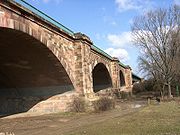.gif)
Theodor Heuss Bridge (Frankenthal)
Encyclopedia

Bundesautobahn 6
, also known as Via Carolina is a 477 km long German autobahn. It starts at the French border near Saarbrücken in the west and end at the Czech border near Waidhaus in the east....
and connects the regions of Rhineland-Palatinate
Rhineland-Palatinate
Rhineland-Palatinate is one of the 16 states of the Federal Republic of Germany. It has an area of and about four million inhabitants. The capital is Mainz. English speakers also commonly refer to the state by its German name, Rheinland-Pfalz ....
with Baden-Wuerttemberg. The four-lane bridge crosses the upper Rhine north of the cities of Ludwigshafen and Mannheim
Mannheim
Mannheim is a city in southwestern Germany. With about 315,000 inhabitants, Mannheim is the second-largest city in the Bundesland of Baden-Württemberg, following the capital city of Stuttgart....
in an east-west direction on the motorway connecting Saarbrücken
Saarbrücken
Saarbrücken is the capital of the state of Saarland in Germany. The city is situated at the heart of a metropolitan area that borders on the west on Dillingen and to the north-east on Neunkirchen, where most of the people of the Saarland live....
, Kaiserslautern
Kaiserslautern
Kaiserslautern is a city in southwest Germany, located in the Bundesland of Rhineland-Palatinate at the edge of the Palatinate forest . The historic centre dates to the 9th century. It is from Paris, from Frankfurt am Main, and from Luxembourg.Kaiserslautern is home to 99,469 people...
, Mannheim, and Viernheim
Viernheim
Viernheim is a midsize industrial town on Mannheim’s outskirts and is found in the Rhine Neckar agglomeration and economic area. It is the second biggest town in Bergstraße district in Hesse, Germany...
. The length of the entire span, which consists of the main river span and two land spans, is over a kilometer long. The land span on the western side is somewhat longer, because the west bank is flatter than the east.
The bridge construction began in 1938. On 12 December 1940 a major accident occurred when the frame collapsed. The construction was then suspended because of the Second World War. Work on the bridge resumed in 1948 and was completed in 1964.
The bridge has no shoulders along the roadway which results in kilometer-long traffic jams during maintenance work and after accidents. A walkway is available along the center of the bridge that allows walkers and cyclists to cross the Rhine. A staircase in the suspension towers allows access to the walkway.

